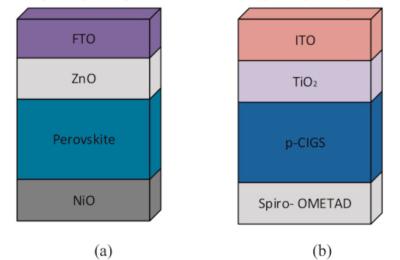Researchers from Southeast University and the University of Liberal Arts Bangladesh have designed and simulated an all-inorganic lead-free tandem photovoltaic cell based on copper, indium, gallium and selenium (CIGS) thin-film technology and perovskite.
The proposed top cell (a) and bottom cell (b), image from Heliyon
The novel device architecture is said to have the potential to reach a power conversion efficiency of 38.39%. “The main objective of this work is to find an efficient combination of non-toxic solar cells with high efficiency so that it saves time and effort before going for fabrication,” the scientists said in their work, noting that the perovskite and materials used for the cell are lead-free.
The proposed solar cell design consists of a top cell using an absorber made of a perovskite material known as CsGe0.5Sn0.5I3 and a bottom cell based on CIGS. Their structural parameters are collectively optimized to attain the highest possible efficiency.
The scientists used the SCAPS-1D solar cell capacitance software, which is a simulation tool for thin-film solar cells that was developed by the University of Ghent in Belgium, to simulate the performance of the separately optimized bottom and top cells. “The PV cell is modeled in this software as a stack of layers, where each layer's thickness, doping, and other physical properties of the materials that make it up are specified,” they explained.
They built the top cell with a nickel(II) oxide (NiO) hole transport layer (HTL), the perovskite absorber, a zinc oxide (ZnO) electron transport layer, and a fluorine-doped tin oxide (TFO) layer. The bottom cell was built with a Spiro-OMeTAD hole-transporting layer, a CIGS absorber, an electron transport layer made of titanium oxide (TiO2), and an indium tin oxide (ITO) layer. The two different HTLs are reportedly able to provide suitable offsets of valence and conduction band distribution.
In order to identify the optimum thickness for the top cell's absorber, the researchers simulated the device by varying the thickness of the absorber from 100 nm to 1000 nm. “It is observed that the efficiency increases gradually from 100 nm to 1000 nm, almost starts to saturate at 800 nm, and then maximizes at 1000 nm with a value of 36.25%,” they stated.
The simulation showed that the top and bottom cells may achieve a potential efficiency of 24.656% and 25.062%, respectively. “For both sub-cells, the current density coincides at around 18.64 mA/cm2, signifying the matching current,” the scientists stated. “The results demonstrate that the voltage of the top cell (1.4885 V) and the bottom cell (1.0006 V) add up to yield a tandem cell voltage of 2.48 V, with the upper top cell dominating due to its relatively open-circuit voltage large value.”
In the simulation, the tandem cell achieved an efficiency of 38.39%, an open-circuit voltage of 2.48 V, a short-circuit current density of 18.64 mA cm−2 and a fill factor of 83.40%. “The proposed tandem structure's performance matrices outperform those stated in the most recent literature,” the research group said.
“The steps associated with the designing are generalized, thus, the proposed method is applicable for tandem cells composed of other materials too,” they also said.




